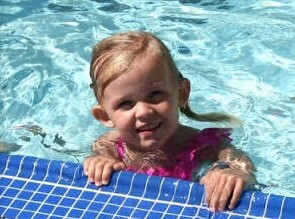Autistic children are given to very special parents who develop the needed patience required to effectively teach them life skills. Swimming is not only a life skill, but alife-saving skill. Some parents may think because their child is autistic, it is unsafe for them to learn to swim; or they would not be able to learn how to swim. This is quite to the contrary. I have seen many boys and girls learn to swim successfully and absolutely love it. However, the journey getting there was not easy and did we acquire a lot of patience.
POOL PREP
Before starting any teaching program with your pool, first go over all of the guidelines to introduce in the pool to your child in a safe manner. These guidelines can be found in my secondary blog, entitled, "Five guidelines for having a pool with children." Before you even take them into the pool, I suggest showing them videos of children swimming. If two parents are available, one could hold the child, while the other models. If there is another sibling available to demonstrate, that will also build confidence. ("If my little sister can, then I can.") Discuss any medications administered prior to starting swimming, as they can cause drowsiness and excitability.
TEACH TO THEIR STRONG POINTS
Autistic children thrive on routines. They do well in consistent settings and are not big fans of change. Lap swimming is all about consistency, repetition, and rhythm. Ironically autistic adults do not get as bored with swimming laps, as non-autistic adults do because they enjoy counting. Children with autism are also are musically and mathematically inclined. Sometimes they will constantly drum the same rhythm with their fingers, or hum the same song over and over. This will work to your advantage in the pool, as you can make a song out of everything you are doing. For instance, "One, two, three, please follow me". Or, "Float, float, float, don't lose your boat!" (A boat is the proper horizontal swimming position which is described and my third blog entailing swimming technique.)
You can also bring out music to keep your child moving. Bobbing up and down in the pool while you're holding your child is a good way to introduce getting ready to go under. You may notice that they keep this bobbing rhythm throughout the lesson, which is fine. It is good exercise and builds up their thigh muscles. It also soothes smaller children (like car rides).
KICK KICK KICK
Kicking that is another rhythmic motion. Have them rest their head on your shoulder and just relax. Constantly reassure them they're okay. Move their whole leg way up and down. Don't just bend their knees. Kicking actually stems from the trunk and hip muscles. It is important that they learn to use their whole leg from the hip to the toe and this will take time. As you move around the pool and say," kick, kick, kick." Use lots of praise. Never use any flotation devices before or during any swim lessons because they will not be able to stretch their bodies out horizontally and kick; nor eventually get their chins to their chests and put their faces under.
AVOID THE POWER STRUGGLE
The last thing you want in the pool is a power struggle with your child. if your child starts to get away from you, calmly tell him/her if you fight me, pinch me, hurt me, or flannel around I will not be able to hold you. Make eye contact. If they persist to flail around, slightly let go and let them start to go down. This may cause panic but they will quickly see that in order for you to protect them, they have to learn to control their bodies. This is a good lesson in itself for autistic and non-autistic children. They will see that they need to just trust you eventually. Speak in a soothing whisper. It is okay to let the scream at first until they get tired and learn the only way out of the pool is by following you. It is not easy for the teacher, but it does work. Try to also give choices so they feel some sense of control. For instance, "Do you want to kick over Narnia at that end of the pool, or Little Mermaid's Cove, over there?" Use any analogy they are familiar with. When practicing kicking, encourage displacing as much water out of the pool as possible. The pool is the one place we can be as messy as we want. Have fun with that.
Cheryl Rains’ bio:
Swim Instructor in San Diego, CA
I have been a public school PE and English/ESL teacher, coach, swim teacher, and tutor for 20 years for all ages. I have also taught privately and in my own business for tutoring, swimming, dancing, tennis, and triathlon. I am a triathlete and have swam for 20 years. I have taught Special Ed and needs children. I have worked with competitive swimmers. I have taught newborns and new mothers. I use the water as a PT tool for MS students, and other students with nerve issues.
ABOUT SUNSATIONAL SWIM SCHOOL
Sunsational Swim School is the 🥇 #1 rated provider of private, at-home swimming lessons in America. We have specialized swim instructors for students ages 6 months to adult, beginner to advanced. Featured on ABC, CBS, Impact 100, The List and others, Sunsational instructors have a minimum of 2 years of teaching experience, are CPR certified and insured, and have collectively taught over 302,223 lessons for more than 74,415 students nationwide!




